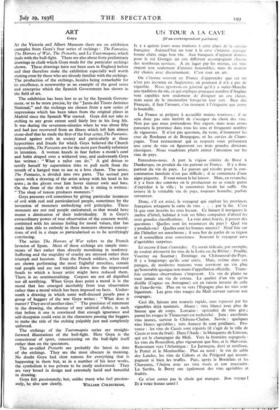ART Goya
AT the Victoria and Albert Museum there are on exhibition examples from Goya's four series of etchings The Fantasies, The Horrors of War,' The Proverbs, and La Tauromaquia, which deals with the bull-fight. There are also about forty preliminary drawings in chalk which Goya made for the particular etchings shown. These drawings have not been seen in England before and they therefore make the exhibition especially well worth visiting even by those who are already familiar with the etchings. The production of the etchings, besides being remarkable for its excellence, is noteworthy as an example of the good sense and enterprise which the Spanish Governmint has shown in the field of art.
The' exhibition has been lent to us by the Spanish Govern- ment, or to be more precise, by the "Junta del Tisoro Artistico National," and the etchings are chosen from a new series of impressions which has been taken from the original plates in Madrid since the Spanish War started. Goya did not take to etching to any great extent until fairly late in his long life. It was during the seventeen-nineties when he was about fifty and had just recovered from an illness which left him almost stone-deaf that he made the first of the four series, The Fantasies.
Aimed against evils in society and particularly at those hypocrisies and frauds for which Goya believed the Church responsible, The Fantasies are for the most part frankly reformist in intention. A woman kneels in fear before a monk's cowl and habit draped over a withered tree, and underneath Goya has written : " What a tailor can do." A girl driven to terrify herself by superstition tries to pull teeth from the mouth of a hanged man to use as a love charm. The series, The - Fantasies, is divided into two parts. The second part opens with a drawing of the artist asleep with his head in his arras ; in the gloom over him hover sinister owls and bats. On the front of the desk at which he is sitting is written : The sleep of reason produces monsters."
Goya presents evil sometimes by giving particular instances of evil with. real and particularised people, sometimes by the invention of monsters embodying evil principles. These monsters -are not real people caricatured, as that would have meant a diminution of their individuality. It is Goya's extraordinary power of true observation of the concrete world, combined with his intense feeling for moral values, that has made him able to embody in these monsters abstract concep- tions of evil in a shape so particularised as to be terrifyingly convincing.
The series The Horrors of War refers to the French invasion of Spain. Most of these etchings are simple state-
ments of fact rather than directly moralising in tendency.
Suffering and the stupidity of cruelty are stressed rather than triumph and heroism. Even the French soldiers, when they are shown performing the most frightful atrocities, remain real people and are not whittled down into the impersonal fiends to which a lesser artist might have. reduced them.
There is no sentimentalising. Corpses are not all dignified nor all terrifying. When Goya does point a moral it is the moral that has emerged inevitably from true observation rather than a moral which has been imposed on facts. Under- neath a drawing in which some weB-dressed people pass a group of beggars of the war Goya writes : " What does it matter? They are of another class." The precision of statement in the drawing, the absence of any satirical cliches, is such that before it one is convinced that enough ignorance and self-deception could exist in the characters passing the beggars to make the title of the etching palpably just and completely unforced.
The etchings of the Tauromaquia series are straight- forward illustrations of the bull-fight. Here Goya is the connoisseur of sport, concentrating on the bull-fight itself rather than on the spectators.
The so-called Proverbs are probably the latest in date of the etchings. They are the most obscure in meaning.
No doubt Goya had clear reasons for everything that is happening in them but, 'as in a number of his later works, the symbolism is too private to be easily understood. They are very broad in design and extremely lucid and beautiful in drawing.
Goya felt passionately, but, unlike many who feel passion-


































 Previous page
Previous page